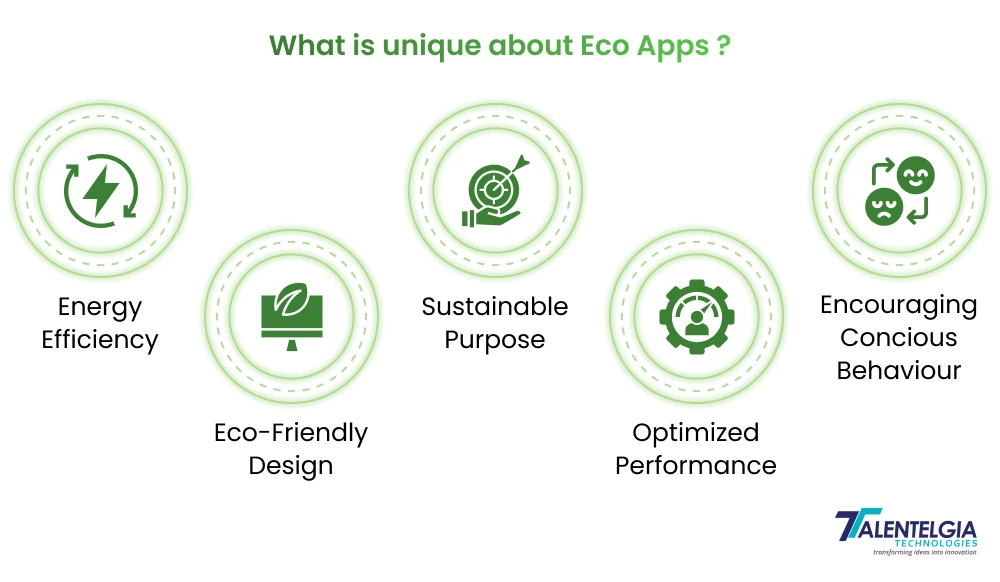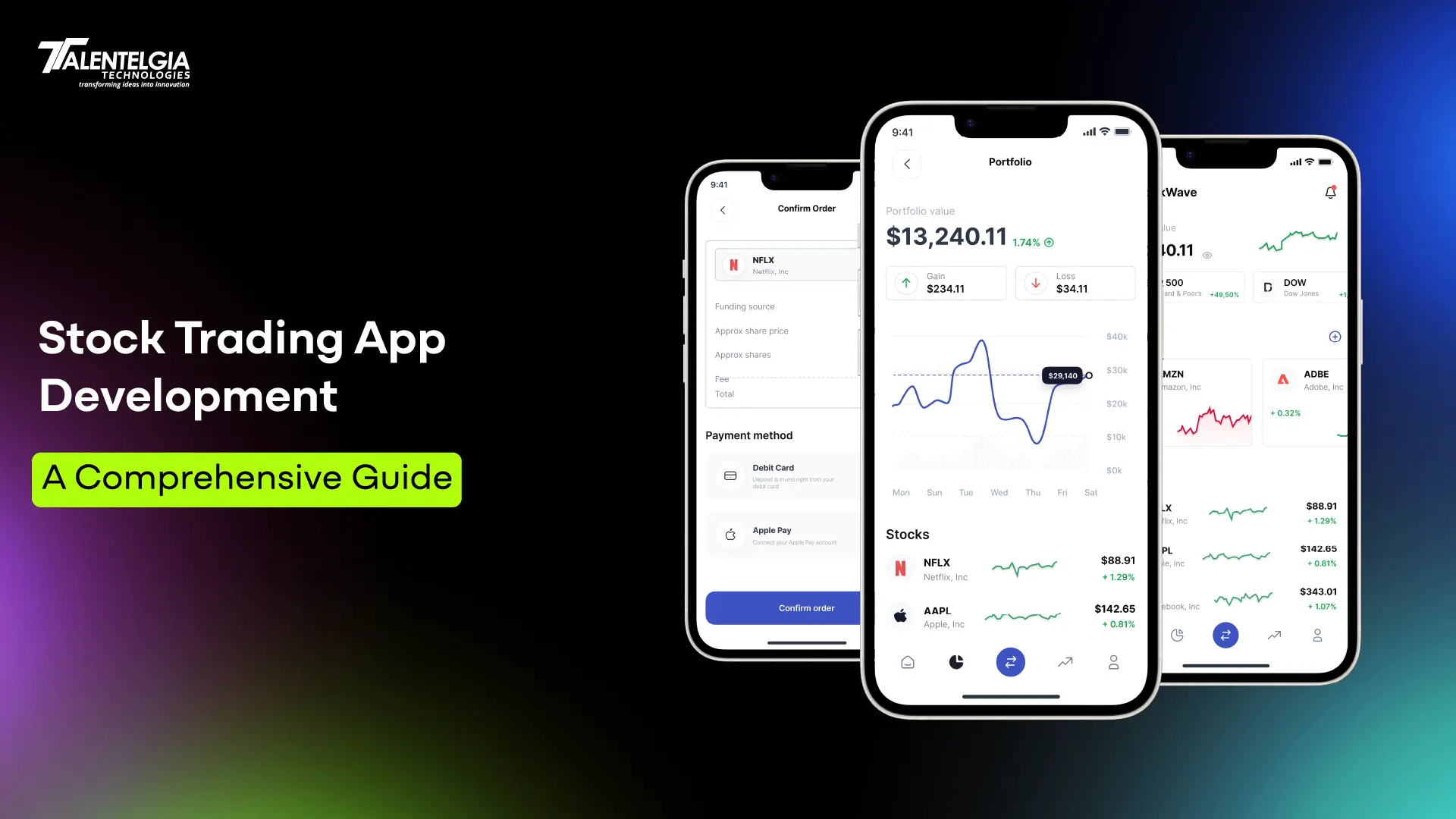In today’s growing interest in the use of apps, we should be concerned about developing apps which should be sustainable as well as beneficial to us in every way possible. Before investing money, time, effort, and resources into app development, it is very important to think not just about the users but also about our environment. Green App Development majorly focuses on solutions that deliver value while minimizing any harm to the environment.
A survey found that 54% of consumers say that sustainability is very important to them and 70% opt the brands that offer eco-friendly apps. This clearly shows a very strong need for a kind of application, i.e, a green app or eco app, which supports sustainable living and does not harm the environment.
Why is a “Green App” needed?
Apps that we use daily for shopping, social media, and gaming seem to be harmless to us, but they hide their environmental costs. Batteries of many apps drain power quickly, which causes the device to heat up or lag in background processes. Many studies in mobile app design show that energy-inefficient coding practices increase power usage and hardware stress.
Adding to this, the contribution of charging the device, updating it, and more into electronic waste/e-waste and carbon emissions over time. The global digital technology sector now accounts for roughly 3-4% of world CO2 emissions. Because of these factors, when we ignore environmental footprints, it harms the environment.
How green apps benefit sustainable development & the environment
A green app is not only designed with the environment in consideration consumes less energy, operates more efficiently, and encourages sustainable user behavior, along with adopting eco-friendly initiatives. Some of the benefits include:
- Low power consumption: Through reasonable design, the deletion of non-essential operating features, and activation of the dormant applications, a green app lowers your power usage.
- Lower carbon print: As people adopt eco-friendly behavior through apps—like preferring public transportation, sharing goods rather than buying new or throwing things away in bulk—the collective impact can contribute to development goals and help the environment. For instance, eco-apps tracking carbon footprint or promoting local sharing can bring tangible and trackable differences.
- And promoting more sustainable behavior: Some green apps have friendly features such as challenges, educational tips, and community sharing. These functions aid in transforming users from just a passive receiver of technology to an active contributor toward the preservation of the environment.”
- Support for sustainable development: Encouraging efficient use of resources, minimizing wastes, and enabling users to make environmentally friendly choices, green apps correspond with the wider goal of sustainable development, defined as meeting the needs of the present without compromising the ability of future generations to meet their own.
In short, if consumer demand for sustainability is growing, coupled with the environmental cost of conventional apps and technology’s power to influence choices, there’s a clear rationale: we need green apps. Their development will not only help mitigate adverse environmental impacts, but it can also provide contributions to sustainable development.
Green App Development
Green apps or eco apps are the apps created with keeping planet in mind. Unlike normal apps that drain our mobile phone’s battery or add to energy waste, eco apps or green apps work smarter. These apps save power, use fewer resources, and encourage sustainability.
They are like small digital helpers that guide users toward better choices, like tracking your carbon footprint, helping you recycle properly, or reminding you to save energy. Conclusively, Eco apps or Green Apps have a goal to balance between technology and nature, which clearly helps to dive into modern life by caring for sustainability too.
If you’re planning to build a sustainable, performance-driven, and energy-efficient mobile app, check out Talentelgia Technologies’ Mobile App Development Services to bring your green app idea to life with the right technology and innovation.
What is unique about Green Apps compared to other apps

When we think about mobile apps, we often focus on how fast they run, how good they look, or how much they can do. But green apps go one step further — they care about how they do it and what impact they leave on the environment.
Unlike regular apps, which mainly focus on user convenience and performance, green apps are built with sustainability in mind. Every part of their design — from how they’re coded to how they use your phone’s battery — is carefully planned to minimize energy waste and carbon footprint.
Here’s what makes them unique:
- Energy Efficiency: Green apps are coded to use less battery and data. They avoid unnecessary background processes, so your phone stays cooler and consumes less electricity.
- Eco-Friendly Design: These apps often use minimalistic interfaces, smaller file sizes, and cloud storage solutions that rely on renewable energy sources.
- Sustainable Purpose: Many green apps aim to solve real environmental issues — like reducing waste, saving water, tracking carbon emissions, or encouraging greener habits.
- Optimized Performance: While most apps focus only on speed, green apps focus on smart performance — ensuring every feature runs efficiently without wasting power or resources.
- Encouraging Conscious Behavior: Some eco apps include features that nudge users to make greener choices, such as biking instead of driving or cutting down on paper usage.
In simple terms, green apps think about the bigger picture. They’re not just about technology; they’re about creating a better, cleaner, and more sustainable future. By combining innovation with responsibility, green apps show that progress doesn’t have to come at the cost of our planet.
Features that constitute ‘Eco Apps’ or ‘Green Apps’ with examples
Green apps aren’t just regular apps with a fancy label — they are built differently, with the environment in mind at every step. From how they’re coded to how users interact with them, each feature in a green app aims to reduce energy use, save resources, and promote sustainable living.
Let’s look at some of the key features that make an app truly “green,” along with a few examples that bring these ideas to life.
1. Energy-Efficient Design
Green apps are designed to use minimal power and data. They load faster, avoid unnecessary animations, and run smoothly even on low-energy devices. This helps conserve your phone’s battery and reduces overall electricity consumption.
Example:
Google Maps’ Eco-Friendly Routing feature allows users to choose routes that save fuel and reduce carbon emissions — showing how small software changes can make a big environmental impact.
2. Sustainable Coding Practices
Behind every eco app is efficient, optimized code. Developers focus on clean programming to ensure the app consumes less processing power and doesn’t overuse device resources. This reduces both battery drain and the environmental footprint of app usage.
Example:
Spotify uses adaptive streaming, adjusting audio quality based on your network speed — reducing data transfer and energy use without affecting user experience.
3. Cloud Optimization and Green Hosting
Many green apps store data on cloud servers that run on renewable energy. By choosing sustainable hosting providers, developers can reduce their app’s carbon footprint and make digital infrastructure more eco-friendly.
Example:
Ecosia, the search engine that plants trees, hosts its servers on 100% renewable energy, ensuring that every search supports the planet rather than harming it.
4. Minimalist and User-Friendly Interface
Eco apps often have simple, clean designs that reduce digital clutter. Fewer visuals, compressed images, and lighter color schemes not only improve performance but also use less device energy.
Example:
Too Good To Go uses a minimalist design to connect users with nearby restaurants offering leftover food at lower prices, reducing food waste and energy used in production.
5. Promoting Sustainable Habits
A unique trait of green apps is their ability to inspire users to live more sustainably. Whether it’s tracking carbon emissions, saving water, or choosing eco-friendly travel options, these apps motivate users to make small but meaningful changes.
Example:
JouleBug gamifies sustainability by rewarding users for eco-friendly actions like biking to work or conserving energy — turning good habits into a fun challenge.
6. Efficient Resource Management
Eco apps use fewer system resources — like RAM, CPU, and storage. This not only improves app performance but also extends the lifespan of mobile devices, reducing electronic waste in the long run.
Example:
Forest helps users stay focused and plant real trees as they avoid distractions, combining productivity with a positive environmental outcome.
7. Transparency and Measurable Impact
Many eco apps allow users to see the impact of their actions, such as the number of trees planted, waste reduced, or energy saved. This transparency helps build trust and encourages long-term engagement.
Example:
Oroeco tracks your carbon footprint based on your spending habits and daily activities, giving you a clear view of your personal environmental impact.
Features of the green app are beyond User Interface or User Design and reflect a strong commitment to sustainability. Whether it’s through clean coding, renewable hosting, or encouraging eco-friendly habits, every aspect of these apps works toward one goal: reducing environmental harm while enhancing user experience.
Green Apps shows that technology does not have to be wasted, but it can be smart, responsible, and sustainable. Also, as most of the developers are adopting these principles, it can completely result in the sustainability of our environment.
Phases of Developing an Eco App / Green App
Creating a green app isn’t just about writing code or designing an interface — it’s about building something that’s good for both people and the planet. The process focuses on being energy-efficient, reducing digital waste, and promoting sustainability in every stage of development.
You can read: Mobile App Development Roadmap: An Expert Guide
Let’s take a closer look at each phase that brings a green app to life.

1. Ideation and Research
Every great product begins with an idea — but for green apps, that idea must also support sustainability. This stage involves thinking deeply about what kind of positive change the app will bring.
Ask questions like:
- How will this app help the environment?
- What specific problem does it solve — energy waste, recycling, or carbon tracking?
- Who will use it, and how can we encourage eco-friendly habits through the app?
During research, developers study user behavior, market needs, and environmental data. They explore how digital solutions can reduce pollution, save energy, or raise awareness about sustainability. The outcome of this phase is a clear, purposeful vision — an app that truly makes a difference.
2. Planning and Strategy
Once the purpose is defined, it’s time to map out the app’s roadmap. This phase sets the foundation for how the app will function, look, and interact with users.
Here, teams plan everything — from the app’s architecture to its visual design. The focus is on choosing the most sustainable options at every step. That means:
- Using lightweight frameworks and optimized libraries.
- Planning for energy-saving features like dark mode or offline access.
- Selecting green hosting providers that run on renewable energy.
This phase is where creative ideas meet practical strategies — ensuring that every technical choice supports environmental responsibility.
3. Design and User Experience (UX)
When it comes to green apps, design isn’t just about aesthetics — it’s about efficiency. The goal is to build an interface that’s simple, elegant, and easy on both users and devices.
Designers often use minimalistic layouts with fewer animations, lighter images, and smooth navigation. These choices make the app load faster and consume less power. If you’re looking to explore more about creating such intuitive and energy-efficient designs, check out this guide on how to design a mobile app interface — it dives deeper into practical design principles that enhance user experience while keeping sustainability in mind.
The color palette may include darker shades or low-brightness tones to extend battery life. For example, using a dark theme can reduce screen energy usage by up to 30% on OLED displays. Even small design decisions like these help make the app more sustainable.
4. Development and Coding
This is the most technical and crucial phase, where ideas and designs turn into reality. Developers write clean, optimized code using the most efficient app development languages that ensure the app runs smoothly without putting too much pressure on the processor or battery.
A few best practices during this stage include:
- Reducing background operations that drain power.
- Compressing media files for faster load times.
- Using APIs efficiently to prevent unnecessary data calls.
Every line of code is written with performance and sustainability in mind. Developers may also test energy consumption throughout the process to identify areas for improvement.
In essence, the development phase is where the true green engineering happens — combining technology with conscious decision-making.
5. Testing and Optimization
Testing is more than just fixing bugs — it’s about making sure the app is as efficient and sustainable as possible.
In this phase, testers monitor how much battery, CPU, and memory the app uses. They also check data transfer, speed, and network load. If any part of the app consumes excessive energy or resources, it’s optimized before release.
Developers often use specialized tools to simulate real-world use and identify “energy hotspots” — parts of the app that use more power than they should. Fine-tuning these areas helps ensure the app runs lightly and efficiently.
6. Deployment and Continuous Improvement
Once testing is complete, the app is ready to launch. But the journey doesn’t end here — maintaining a green app is an ongoing commitment.
After release, developers continue to monitor performance and user feedback. Regular updates help keep the app optimized, compatible with new devices, and energy-efficient.
The team also evaluates real-world environmental impact — for example, how much energy the app helps users save or how many eco-friendly actions it encourages.
This phase is about learning, improving, and evolving — ensuring that the app remains aligned with its sustainability goals over time.
The development of a green app is a journey of purpose and innovation. It’s not just about creating another digital product — it’s about building something meaningful that makes technology part of the solution, not the problem.
Each phase, from idea to launch, is guided by responsibility toward the environment. And when done right, a green app becomes more than just a tool — it becomes a way to make everyday life a little more sustainable.
Challenges That You Can Face
While building a green app sounds inspiring and forward-thinking, the journey isn’t always smooth. Developers and businesses often face a few real-world challenges when trying to balance technology with sustainability. These challenges can be technical, financial, and even related to user behavior — but each one offers valuable lessons that push innovation forward.
Let’s take a closer look at some of the most common challenges in green app development:
1. Balancing Performance and Sustainability
One of the toughest challenges is finding the sweet spot between performance and energy efficiency. When developers optimize an app to consume less power, it can sometimes affect speed or visual quality. The goal, therefore, is to ensure the app runs smoothly without sacrificing the user experience — and that requires careful coding, testing, and creative problem-solving.
2. Higher Initial Development Costs
Ever wonder How Much it costs to develop an App? Green app development may require specialized frameworks, testing tools, and hosting providers that support renewable energy — all of which can increase upfront costs. However, these costs usually balance out over time, as efficient apps require fewer updates, consume less energy, and perform better in the long run.
3. Limited Awareness Among Users
Even the most sustainable app can struggle if users aren’t aware of its value. Many people still don’t realize how much energy everyday digital activities consume. Educating users about the importance of green apps and the role they play in environmental protection becomes just as important as building the app itself.
4. Finding Green Infrastructure
Not all hosting platforms or cloud providers operate on renewable energy. Finding the right infrastructure — one that aligns with sustainability goals — can take time and research. Developers must look for partners and data centers that are committed to using green power and eco-efficient servers.
5. Keeping Up With Changing Sustainability Standards
Sustainability isn’t static — it evolves with technology and global policies. Developers need to stay updated with new green coding practices, energy-efficiency metrics, and industry standards. Continuous learning and adapting are key to ensuring that an app remains truly eco-friendly over time.
Despite these challenges, every hurdle faced during green app development is a step toward progress. It’s not about perfection but constant improvement and conscious innovation. Each eco app built today becomes a part of a bigger mission — creating a digital world that respects and preserves the environment.
Read More: App Development Consultant: How to Hire, Cost, and Benefits
Final Words
As we move deeper into a technology-driven world, it’s time we realize that innovation and sustainability must go hand in hand. Green apps are not just another tech trend — they’re a reflection of responsibility, awareness, and care for the planet we live on.
By adopting green app development practices, developers can design apps that do more than just serve users; they can serve a larger purpose — protecting our environment. These apps save energy, reduce digital waste, and encourage users to live more consciously.
Every eco app created is a small but powerful contribution to the world’s sustainability goals. It reminds us that every choice — every line of code, every design decision, every download — matters.
In the end, building green apps isn’t just about the future of technology; it’s about the future of our planet.


 Healthcare App Development Services
Healthcare App Development Services
 Real Estate Web Development Services
Real Estate Web Development Services
 E-Commerce App Development Services
E-Commerce App Development Services E-Commerce Web Development Services
E-Commerce Web Development Services Blockchain E-commerce Development Company
Blockchain E-commerce Development Company
 Fintech App Development Services
Fintech App Development Services Fintech Web Development
Fintech Web Development Blockchain Fintech Development Company
Blockchain Fintech Development Company
 E-Learning App Development Services
E-Learning App Development Services
 Restaurant App Development Company
Restaurant App Development Company
 Mobile Game Development Company
Mobile Game Development Company
 Travel App Development Company
Travel App Development Company
 Automotive Web Design
Automotive Web Design
 AI Traffic Management System
AI Traffic Management System
 AI Inventory Management Software
AI Inventory Management Software
 AI Software Development
AI Software Development  AI Development Company
AI Development Company  AI App Development Services
AI App Development Services  ChatGPT integration services
ChatGPT integration services  AI Integration Services
AI Integration Services  Generative AI Development Services
Generative AI Development Services  Natural Language Processing Company
Natural Language Processing Company Machine Learning Development
Machine Learning Development  Machine learning consulting services
Machine learning consulting services  Blockchain Development
Blockchain Development  Blockchain Software Development
Blockchain Software Development  Smart Contract Development Company
Smart Contract Development Company  NFT Marketplace Development Services
NFT Marketplace Development Services  Asset Tokenization Company
Asset Tokenization Company DeFi Wallet Development Company
DeFi Wallet Development Company Mobile App Development
Mobile App Development  IOS App Development
IOS App Development  Android App Development
Android App Development  Cross-Platform App Development
Cross-Platform App Development  Augmented Reality (AR) App Development
Augmented Reality (AR) App Development  Virtual Reality (VR) App Development
Virtual Reality (VR) App Development  Web App Development
Web App Development  SaaS App Development
SaaS App Development Flutter
Flutter  React Native
React Native  Swift (IOS)
Swift (IOS)  Kotlin (Android)
Kotlin (Android)  Mean Stack Development
Mean Stack Development  AngularJS Development
AngularJS Development  MongoDB Development
MongoDB Development  Nodejs Development
Nodejs Development  Database Development
Database Development Ruby on Rails Development
Ruby on Rails Development Expressjs Development
Expressjs Development  Full Stack Development
Full Stack Development  Web Development Services
Web Development Services  Laravel Development
Laravel Development  LAMP Development
LAMP Development  Custom PHP Development
Custom PHP Development  .Net Development
.Net Development  User Experience Design Services
User Experience Design Services  User Interface Design Services
User Interface Design Services  Automated Testing
Automated Testing  Manual Testing
Manual Testing  Digital Marketing Services
Digital Marketing Services 
 Ride-Sharing And Taxi Services
Ride-Sharing And Taxi Services Food Delivery Services
Food Delivery Services Grocery Delivery Services
Grocery Delivery Services Transportation And Logistics
Transportation And Logistics Car Wash App
Car Wash App Home Services App
Home Services App ERP Development Services
ERP Development Services CMS Development Services
CMS Development Services LMS Development
LMS Development CRM Development
CRM Development DevOps Development Services
DevOps Development Services AI Business Solutions
AI Business Solutions AI Cloud Solutions
AI Cloud Solutions AI Chatbot Development
AI Chatbot Development API Development
API Development Blockchain Product Development
Blockchain Product Development Cryptocurrency Wallet Development
Cryptocurrency Wallet Development About Talentelgia
About Talentelgia  Our Team
Our Team  Our Culture
Our Culture 
 Healthcare App Development Services
Healthcare App Development Services Real Estate Web Development Services
Real Estate Web Development Services E-Commerce App Development Services
E-Commerce App Development Services E-Commerce Web Development Services
E-Commerce Web Development Services Blockchain E-commerce
Development Company
Blockchain E-commerce
Development Company Fintech App Development Services
Fintech App Development Services Finance Web Development
Finance Web Development Blockchain Fintech
Development Company
Blockchain Fintech
Development Company E-Learning App Development Services
E-Learning App Development Services Restaurant App Development Company
Restaurant App Development Company Mobile Game Development Company
Mobile Game Development Company Travel App Development Company
Travel App Development Company Automotive Web Design
Automotive Web Design AI Traffic Management System
AI Traffic Management System AI Inventory Management Software
AI Inventory Management Software AI Software Development
AI Software Development AI Development Company
AI Development Company ChatGPT integration services
ChatGPT integration services AI Integration Services
AI Integration Services Machine Learning Development
Machine Learning Development Machine learning consulting services
Machine learning consulting services Blockchain Development
Blockchain Development Blockchain Software Development
Blockchain Software Development Smart contract development company
Smart contract development company NFT marketplace development services
NFT marketplace development services IOS App Development
IOS App Development Android App Development
Android App Development Cross-Platform App Development
Cross-Platform App Development Augmented Reality (AR) App
Development
Augmented Reality (AR) App
Development Virtual Reality (VR) App Development
Virtual Reality (VR) App Development Web App Development
Web App Development Flutter
Flutter React
Native
React
Native Swift
(IOS)
Swift
(IOS) Kotlin (Android)
Kotlin (Android) MEAN Stack Development
MEAN Stack Development AngularJS Development
AngularJS Development MongoDB Development
MongoDB Development Nodejs Development
Nodejs Development Database development services
Database development services Ruby on Rails Development services
Ruby on Rails Development services Expressjs Development
Expressjs Development Full Stack Development
Full Stack Development Web Development Services
Web Development Services Laravel Development
Laravel Development LAMP
Development
LAMP
Development Custom PHP Development
Custom PHP Development User Experience Design Services
User Experience Design Services User Interface Design Services
User Interface Design Services Automated Testing
Automated Testing Manual
Testing
Manual
Testing About Talentelgia
About Talentelgia Our Team
Our Team Our Culture
Our Culture

















 Write us on:
Write us on:  Business queries:
Business queries:  HR:
HR: 




